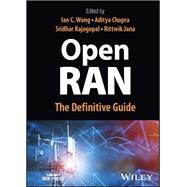A comprehensive survey of Open RAN technology and its ecosystem
In Open RAN: The Definitive Guide, a team of distinguished industry leaders deliver an authoritative guide to all four principles of the Open RAN vision: openness, virtualization, intelligence, and interoperability. Written by the industry experts currently defining the specifications, building the systems, and testing and deploying the networks, the book covers O-RAN architecture, the fronthaul interface, security, cloudification, virtualization, intelligence, certification, badging, and standardization.
This critical reference on Open RAN explains how and why an open and disaggregated, intelligent, and fully virtualized network is the way networks should be designed and deployed moving forward. Readers will also find:
- A thorough introduction from key industry players, including AT&T, Telefonica, Mavenir, VMWare, Google and VIAVI
- Comprehensive explorations of Open X-Haul transport networks and other unique 5G capabilities
- Practical discussions of the four pillars of O-RAN architecture: openness, virtualization, intelligence, and interoperability
- Comprehensive treatments of how smaller vendors can introduce their own services and customize the network
Perfect for engineers, product managers, and marketing professionals in the telecom industry, Open RAN: The Definitive Guide will also benefit graduate students, researchers, and engineers in government agencies with involvement in the wireless and telecom industries.









